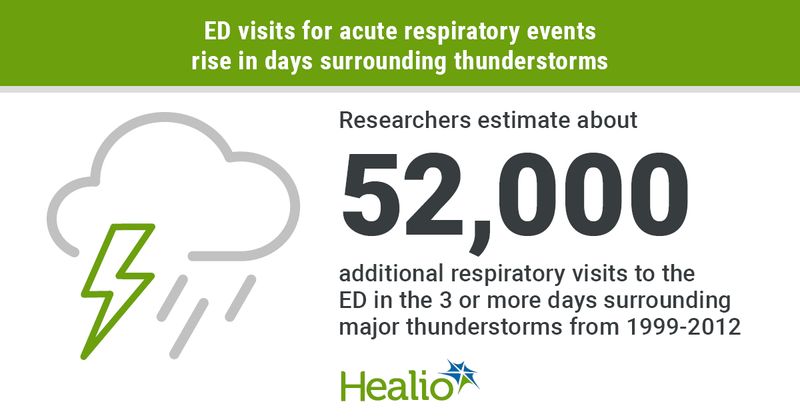ED visits for acute respiratory illnesses rise before thunderstorms
In a large-scale study, ED visits for thunderstorm-related acute respiratory illnesses were increased in older U.S. adults, including those with asthma and COPD, according to findings published in JAMA Internal Medicine.
“Thunderstorm-related atmospheric changes are expected to increase in severity with rising global temperatures,” Eric Zou, PhD, assistant professor of economics at the University of Oregon, and colleagues wrote. “Although large-scale evidence is limited, vulnerable populations such as older adults or those with common chronic respiratory diseases like asthma or chronic obstructive pulmonary disease are expected to be susceptible to negative health effects from these changes.”

Researchers analyzed atmospheric and lightning data from the U.S. National Oceanic and Atmospheric Administration from all 3,127 counties in the U.S. from January 1999 to December 2012. To identify ED visits with acute respiratory diagnoses, the researchers compared these data with insurance claims and comorbidity data from 46,581,214 Medicare beneficiaries aged older than 65 years (mean age, 77 years; 58.6% women). Overall, 12,334,021 (26.5%) had COPD, 4,891,027 (10.5%) had a chronic diagnosis of asthma, and 3,074,360 (6.6%) had asthma and COPD. Zou and colleagues identified 22,118,934 respiratory ED visits and 822,095 county days with major thunderstorms, which were defined as the presence of lightning, precipitation and above-median wind speed.
ED visits above the baseline were increased in the day before a thunderstorm, with:
- a mean 1.8 (95% CI, 1.4-2.1) additional visits per million Medicare beneficiaries overall;
- 6.3 (95% CI, 4.1-8.6) additional visits per million Medicare beneficiaries for individuals with asthma;
- 6.4 (95% CI, 5.0-7.8) additional visits per million Medicare beneficiaries for individuals with COPD; and
- 9.4 (95% CI, 6.2-12.7) additional visits per million Medicare beneficiaries for individuals with both asthma and COPD.
ED visits were also elevated in the 3 or more days surrounding a thunderstorm, with:
- a mean 5.3 (95% CI, 3.8-6.8) additional visits per million Medicare beneficiaries overall;
- 22.5 (95% CI, 16.0-29.2) additional visits per million Medicare beneficiaries for individuals with asthma;
- 22.4 (95% CI, 17.4-27.4) additional visits per million Medicare beneficiaries for individuals with COPD; and
- 33.8 (95% CI, 24.0-43.6) additional visits per million Medicare beneficiaries for individuals with both asthma and COPD.
According to the researchers, assuming an average population of 37.7 million Americans aged 65 years or older, approximately 52,000 additional ED visits for respiratory illnesses were estimated to occur in the 3 or more days surrounding the day of a thunderstorm from 1999 to 2012.
The researchers reported no association between thunderstorms and ED visits for sepsis or pulmonary embolism.
“Our findings suggest antecedent rises in particulate matter concentration and temperature may be the dominant mechanism of thunderstorm-associated acute respiratory disease in older Americans, which may contribute to strain on the health care system as storm activity increases with rising global temperatures,” the researchers wrote.

